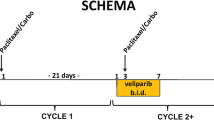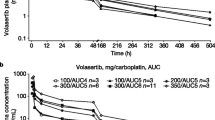Abstract
The anti-epileptic diphenylhydantoin (DPH; Dilantin®) selectively enhances the in vitro cytotoxicity of vinca microtubule poisons in both parent sensitive and multi-drug resistant (MDR) human tumor cells. The in vivo clinical activity of this combination has not been fully evaluated. Purpose: To determine the maximum tolerated dose (MTD), dose-limiting toxicities, and preliminary antitumor activity of the combination of intravenous (IV) bolus vinorelbine (VRL) and oral diphenylhydantoin (DPH) in patients (pts) with refractory solid tumors. Methods: Cohorts of 3–6 pts with refractory cancer were treated with escalating doses of weekly IV bolus VRL (I –20.0 mg/m2; II –22.5 mg/m2; III –25.0 mg/m2; IV –27.5 mg/m2; V –30.0 mg/m2; VI –32.5 mg/m2) combined with a fixed oral dose of DPH (400 mg/day) until MTD or progression. During each 35 day cycle, pts received DPH 400 mg/day administered orally on Days −6 to Day +22 and weekly IV bolus infusion of VRL on Days +1, +8, +15, and +22. The cohort treated at the MTD was expanded to further define toxicity. Results: A total of 25 evaluable pts. (9 men; 16 women) were treated with VRL and DPH at dose levels I (n = 5), II (n = 3), III (n = 2), IV (n = 3), V (n = 7) and VI (n = 5) in 5 week cycles over a 16 month period. Dose limiting toxicity occurred at dose level VI (VRL 32.5 mg/m2) and included grade 3 leukopenia (n = 2), grade 3 neutropenia (n = 1) and grade 4 neutropenia (n = 1) occurring within the first cycle of treatment. There were no responses, however 9 pts had stable disease of variable duration (8–56 weeks) and received a median of 2 cycles of treatment (range 2–14). Conclusion: Intravenous bolus administration of VRL and oral administration of a fixed dose of DPH was well tolerated according to the schedule reported here. Although there were no responses, several patients had prolonged disease stabilization. The recommended phase II dose of VRL when used in this combination is 30 mg/m2.
Similar content being viewed by others
References
Van Tellingen O, Sips JHM, Beijnen JH, Bult A, Nooijen WJ: Pharmacology, bio-analysis and pharmacokinetics of the vinca alkaloids and semi-synthetic derivatives. Anticancer Res 12: 1699–1716, 1992
Edincott JA, Ling V: The biochemistry of P. gylcoprotein mediated multidrug resistance. Ann Rev Biochem 58: 137–171, 1989
Rowinsky EK, Donehower RC: The clinical pharmacology and use of antimicrotubule agents in cancer chemotherapeutics. Pharmac Thera 52: 35–84, 1991
Ford JM, Hait WN: Pharmacology of drugs that alter multidrug resistance in cancer. Pharm Rev 42: 155–199, 1990
Dumontet C, Sikic BI: Mechanisms of action of and resistance to antitubulin agents: Microtubule dynamics, drug transport and cell death. J Clin Oncol 17: 1061–1070, 1999
Cros S, Potier P: La Nor-anhydrovinblastine (Navelbine) Nouveau type de compose antitumoral du groupe de la vinblastine. Collogue de Marrakech (Maroc): 16–20, 1985
Mangeney P, Andriamialisoa RZ, Langlois Y: A new class of antitumor compounds: 5′-nor and 5′,6′-seco derivatives of vinblastine type alkaloids. Journal of Organic Chemistry 44: 3765–3771, 1979
Potier P: The synthesis of Navelbine prototype of a new series of vinblastine derivatives. Semin Oncol 16(2 Suppl 4): 2–4, 1989
Binet S, Fellous A, Meininger V: In situ analysis of the action of Navelbine on various types of microtubules using immunofluorescence. Semin Oncol 16(Suppl 4): 5–8, 1989
Fellous A, Ohayon R, Vacassin T, Binet S, Lataste H, Krikorian A, Couzinier JP, Meininger V: Biochemical effects of Navelbine on tubulin associated proteins. Semin Oncol 16(Suppl 4): 9–14, 1989
Himes RH, Kersey RN, Hellier-Bettinger I, Samson FE: Action of vinca alkaloids vincristine, vinblastine and desacetylvinblastine amide on microtubules in vitro. Cancer Res 36: 3798–3801, 1976
Cvitkovic E, Izzo J: The current and future place of vinorelbine in cancer therapy. Drugs 44(Suppl 4): 36–45, 1992
Hohneker JA: A summary of vinorelbine (Navelbine) safety data from North American clinical trials. Semin Oncol 21(Suppl 10): 42–60, 1994
Canobbio L, Boccardo F, Guarneri D, Calabria C, Decensi A, Curotto A, Martorana G, Giuliani L: Phase II study of Navelbine in advanced renal cell carcinoma. Eur J Cancer 27(6): 804–805, 1991
Mahjoubi M, Kattan J, Droz J, Philippot I, Pautier P, Boutan-Laroze A, Azub M, Theodore C: Feasibility trial of a combination of vinorelbine, ifosfamide, fluorouracil and folinic acid (VIF regimen) in advanced urothelial cancer. Eur J Cancer 29A(2): 285–286, 1993
Bruni GS, Posca T, Celiento G: Gemcitabine and navelbine in elderly patients with bladder cancer: pilot study (Abstract). Proc Eur Soc Med Oncol 23: 307a, 1998
Sobecks RM, Stadler WM, Daugherty CK, Ratain MJ, Voglezang NJ: Vinorelbine and paclitaxel in relapsed metastatic bladder carcinoma (Abstract). Proc Am Soc Clin Oncol 16: 344a, 1997
Le Cesne A, Droz JP, Kattan J: Phase II trial of a combination of ifosfamide, Navelbine, and epirubicin as salvage chemotherapy in refractory germ cell tumors (Abstract). Proc Am Soc Clin Oncol 10: 174a, 1991
Bokemeyer C, Droz JP, Hanauske A: Treatment of relapsed non-seminomatous germ-cell tumors with vinorelbine-a trial of the phase I-II study group of the Association for Medical Oncology of the German Cancer Society. Onkologie 16(1): 29–31, 1993
Van Zuylen L, Nooter K, Sparreboom A, Verweij J: Development of multidrug-resistance convertors: Sense or nonsense? Invest New Drugs 18: 205–220, 2000
Ganapathi R, Hercbergs A, Grabowski D, Ford J: Selective enhancement of vincristine cytotoxicity in multidrug resistant tumor cells by Dilantin (phenytoin). Cancer Res 53: 3262–3265, 1993
Kawamura KI, Grabowski D, Weizer K, Bukowski R, Ganapathi R: Modulation of vinblastine cytotoxicity by dilantin (phenytoin) or the protein phosphatase inhibitor okadaic acid involves the potentiation of anti-mitotic effects and induction of apoptosis in human tumour cells. Br J Cancer 73(2): 183–188, 1996
Peereboom DM, Ganapathi R, Van Tellingen O, Grabowski D, Olencki T, Budd GT, Wood L, McLain DA, Bukowski RM: Phase I trial of vinblastine plus phenytoin: Pharmacokinetic analysis (Abstract). Proc Annu Meet Am Assoc Cancer Res 37: A1243, 1996
Perry MC: Appendix: WHO toxicity guidelines. In: Perry MC (ed) The Chemotherapy Source Book. Baltimore, MD, Williams and Wilkins; 1992, pp. 1132–1144
Kornblith PL, Callahan LV, Caswell PA: Growth-inhibitory effects of dipenhnylhydantoin of human brain tumor cells in culture. Neurosurgery 2: 122–127, 1978
Estus S, Blumer JL: Role of microtubule assembly in phentyotin teratgenic action in the sea urchin (Arabica puntulata) embryo. Mol Pharmacol 36: 708–715, 1989
Goa KL, Faulds D: Focus on vinorelbine. Drugs and Aging 5(3): 201–202, 1994
Furuse K, Niitani H, Wakui A: Phase I study on vinorelbine by single or intermittent administration (Abstract). Invest New Drugs 7: 456, 1989
Berthaud P, Le Chavalier T, Ruffle P, Baldoyrou P, Arriagada R, Bosson F, Tursz T: Phase I–II study of vinorelbine plus cisplatin in advanced non-small cell lung cancer. Eur J Cancer 28A: 1863–1865, 1992
Jassem J, Karnicka-Mlodkowska, van Pottelsberghe C, van Glabbeke M, Noseda MA, Ardizzonia A, Gozzelino F, Planting A, van Zandwijk N: Phase II study of vinorelbine in previously treated small cell lung cancer patients. Eur J Cancer 29A(12): 1720–1722, 1993
Gasparini G, Caffo O, Barni S, Frontini C, Testolin A, Guglielmi RB, Ambrosini G: Vinorelbine, is an active antiproliferative agent in pretreated advanced breast cancer patients: A Phase II study. J Clin Oncol 12: 2094–2101, 1994
Author information
Authors and Affiliations
Rights and permissions
About this article
Cite this article
Hutson, T.E., Ganapathi, R., Elson, P. et al. Phase I trial of vinorelbine and diphenylhydantoin in patients with refractory carcinoma. Invest New Drugs 22, 277–284 (2004). https://doi.org/10.1023/B:DRUG.0000026253.02502.ce
Issue Date:
DOI: https://doi.org/10.1023/B:DRUG.0000026253.02502.ce




